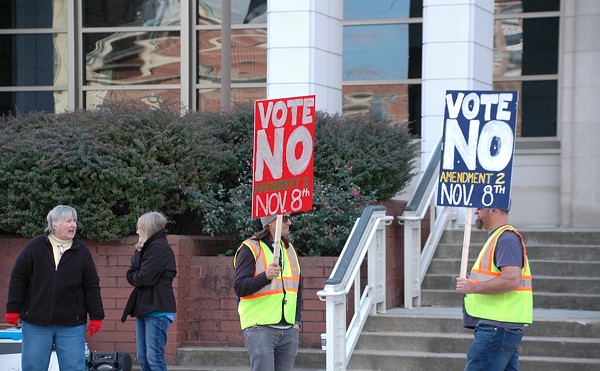The new year started with hope for improved relations between Cincinnati Police and African Americans but ended with the spectre of officers standing 24-hour guard for the Ku Klux Klan. In between came new complaints of racial discrimination, the controversial death of two black men in police custody, calls for a federal investigation of alleged police brutality — and an initiative that just might lead to progress.
Police Chief Tom Streicher Jr. signaled a new approach to discussions of racial conflict in Cincinnati during a January speech at Mount Auburn Presbyterian Church: He told the truth. At a forum on "Driving While Black," Streicher admitted police have sometimes stopped drivers because they're black ("It's a Black Thing," issue of Feb. 10-16).
"All I can do is ask for forgiveness for transgressions in the past," Streicher said.
The chief's acknowledgment that racial profiling is real might have increased the credibility of city officials who say they're sensitive to African-American concerns. But the police division's handling of Ujima Cincibration, a black cultural festival July 28-30, seemed to reinforce the belief that discrimination is entrenched.
In an effort to reduce traffic gridlock, police closed nearly all downtown streets between Central Parkway and the Ohio River on two of the three nights of Ujima. The festival draws an estimated 150,000 people downtown, and police said youths cruising in cars caused potential delays for emergency vehicles ("Oktoberfest Uber Alles," Sept. 14-20).
Restaurant owners used the road closings to justify closing during the festival, saying their customers couldn't get downtown.
But the road closings didn't come until 11 p.m., and black leaders saw the restaurant closings as a deliberate affront to the thousands of African Americans in town for Ujima.
The insult seemed all the more clear when Oktoberfest Zinzinnati attracted 500,000 people downtown in the fall. Police closed only a single street. Restaurants that had closed during Ujima stayed open for the festival of German heritage and beer-drinking.
Outrage over Ujima led to the formation of Black United Front, a group headed by Rev. Damon Lynch III. For several weeks members of the group picketed restaurants, continuing until a federal mediator arranged a truce in October. Restaurant owners issued a statement saying they had intended no slight by closing during Ujima. Although the statement didn't use the words "apology," "wrong" or "sorry," Black United Front said it accepted the restaurateurs' apology and would begin focusing on curfew enforcement and other issues raised during Ujima ("Sorry' Seems to Be the Hardest Word," Oct. 19-25).
Sept. 1 brought a double tragedy, the deaths of a 12-year-old boy and Officer Kevin Crayon, both black, during an early morning struggle in a Mount Airy parking lot. When Crayon saw Courtney Mathis, 12, get into a car and start to drive away, he reached into the car and became entangled. On Colerain Avenue, still dangling from the car, Crayon shot the boy to death and was thrown onto the street, sustaining a fatal head injury ("Who Killed Whom in Mount Airy?," Sept. 14-20).
Fraternal Order of Police President Keith Fangman delivered himself of his usual venom, calling Courtney a "punk." Some observers pointed to Crayon's decision to reach into a moving car, contrary to training — the same circumstance that preceded the police killing of a black man in Cincinnati a year earlier. But the families of the dead child and the dead officer, linked by their church membership, said they had nothing but compassion for each other's loss.
No such nobility, but rather suspicion, followed the Nov. 7 death of Roger Owensby Jr., who was suffocated during an arrest. Owensby's death is now a criminal investigation, with five police officers refusing to answer questions, including the reason for the arrest.
As if racial concerns couldn't be more aggravated, a second black man died in police custody within 24 hours of Owensby. An officer shot and killed shoplifting suspect Jeffrey Irons after Iron allegedly grabbed an officer's weapon and shot him in the hand.
Reaction to Owensby's death was swift and angry. Even Mayor Charlie Luken called for an investigation by the U.S. Justice Department, which is now underway. Hamilton County Prosecutor Michael Allen has said he will submit the Owensby death to a grand jury. Allen is a former Cincinnati Police officer.
Suspicion wasn't necessary for anyone looking for signs of racial conflict earlier this month in Cincinnati, when the Ku Klux Klan planted a cross on Fountain Square. City council demurred from denying the KKK a permit to use the square, saying the white supremacists had a constitutional right to demonstrate. But the city went beyond mere permission, providing a 24-hour police guard for the cross for several days — a decision city officials later said showed poor judgment.
If race relations are largely a matter of perspective, so, too, is police use of force, as radio listeners learned recently. In mid-November, protesters demonstrated for three days against globalization of the economy. After 52 people were arrested and a handful sprayed with chemical irritant, many TransAtlantic Business Dialogue (TABD) demonstrators complained police violated their rights by conducting illegal searches and by using excessive force ("Black and Blue," Nov. 22-29).
On Dec. 16, however, Officer Scott Johnson described to WDBZ (1230 AM) listeners the treatment given TABD protesters as far gentler than that afforded African-American suspects in Cincinnati. Johnson, president of the Sentinels, an organization of black police officers, said the white protesters got rubber bullets while black suspects too often get the real thing.
In the midst of it all, the city saw an initiative that just might make a difference. The Chairman's Roundtable on Public Safety, launched by City Councilman Charlie Winburn, has fostered a dialogue among diverse elements of the community, including Streicher, gay-rights advocates, African-American activists, neighborhood organizations and representatives of social-service agencies. The 60-member panel expects to issue a report soon. ©





